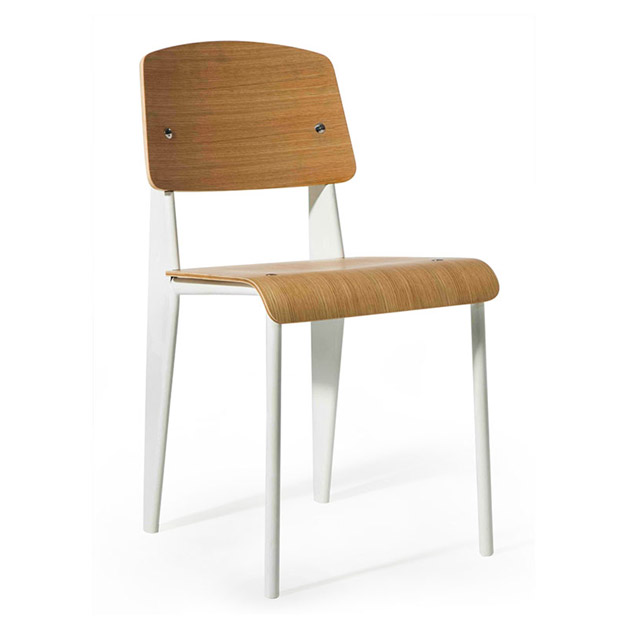What is Mid-Century?
Modern Reminiscences from the Mid Century - How Design Reflects Our Timeless World
Why does the term “mid century modern” sound so elusive? It can be difficult to define “mid-century modern,” but when it comes to design we can at least shine a spotlight on some of its fundamentals capturing a glimpse into history and a reflector for our present day world.
If we think back to the 1950s and 60s, where the term really solidified itself as a specific style, there was an enormous amount of influences shaping its origin and evolution. From the more abstract and biomorphic shapes to clean-cut lines and rigid geometric forms, mid century modern designers followed a versatile recipe combining sculptural art, sensible architecture and cultural richness into their pieces.
Mid century modern designers like Harry Bertoia, Arne Jacobsen, Eero Saarinen, Jean Prouve, George Nelson, Alvar Aalto, Hans Wegner, Poul Kjaerholm, and Charles and Ray Eames (just to name a few!) are considered to be the main pioneers of this movement. It’s not surprising to find out many of whom have their roots planted in either craftsmanship, fine artistry or architectural studies.

In 1968, for example, Finnish designer Eero Aarnio created his iconic Bubble Chair. The chair is spherical yet sliced on one side, made of acrylic and is hung from the ceiling by a chain, suspended in the air with no legs whatsoever. The Bubble chair is seemingly “floating in space.” His inspiration for this design was drawn from the pop art movement of the era fused with his own concept of space age futurism.
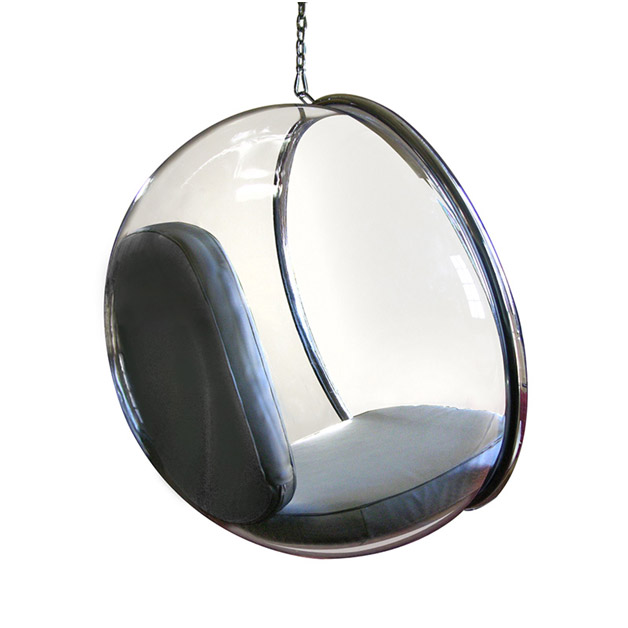 Shown above: Eero Aarnio Bubble Chair
Shown above: Eero Aarnio Bubble Chair
Similarly to his Bubble chair, the Eero Aarnio Ball Chair was another shining example of Aarnio’s vision, also spherical but made of molded fiberglass with a circular aluminum base. The Ball chairs exterior color is in glossy white and the interior fabric featured a playful array of vibrant, solid, pop colors like lime green, red and yellow. The rounded shape of the chair enclosed the individual in a nest-like vessel making it extra cozy and super futuristic. An innovative rendition of Aarnio’s Ball Chair called the Stereo Ball Chair can be found today with an added contemporary touch of surround sound speakers actually built within the Ball Chairs interior design.
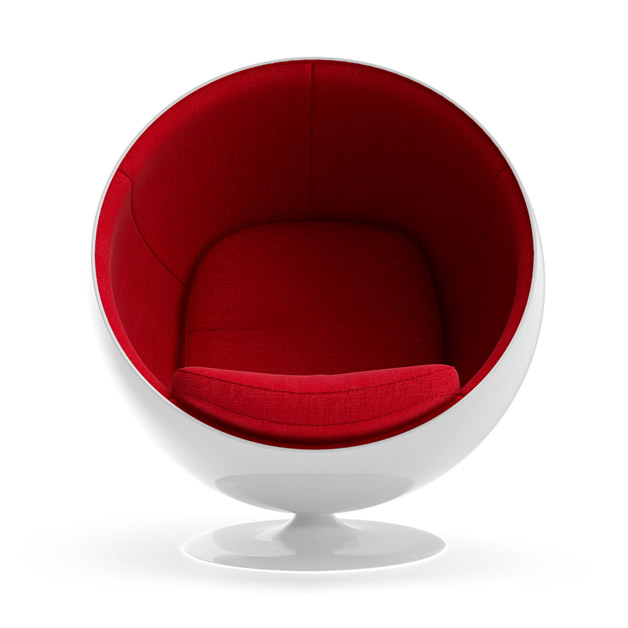 Shown above: Eero Aarnio Ball Chair
Shown above: Eero Aarnio Ball Chair
Italian-born designer, Harry Bertoia, on the other hand, took a different approach to his mid-century modern furniture. His most famous design, the Diamond chair was created in 1952 and reflected his background as a sculptor. The Diamond Chair was made of steel mesh and shaped in such a way as to mold to the contours of the body. The Bertoia Wire Diamond Chair, resembled the skeleton model to a chair waiting to be upholstered. However, the genius of the design was in the way the Diamond chair looked like framework. In a true sculpturesque fashion, Bertoia accounted for the spaces in between and around the design whilst as a true designer also chose materials that were sturdy but comfortable to lounge in.
Shown above: Bertoia Wire Diamond Chair
Danish designer, Hans Wegner was a master woodworker, apprenticing in a local cabinetmakers shop at the age of 13, he.emphasized the importance of craftsmanship and artistry whilst adding a contemporary touch to classic designs from earlier decades. For example, his well-known Peacock Chair with its elongated, fanned backrest resembles a traditional 19th century English Windsor seat. Another example of Wegners style is the JH 501 Round Chair. The JH 501 Round Chair featured a sculpted wooden frame and cane seat with a biomorphic shaped back rest. Ironically enough, Wegners mid-century modern round chair became known as the “The Classic Chair.” Wegners designs showcased the use of harder materials like wood that were finely sculpted into more sensuous and organic shapes.
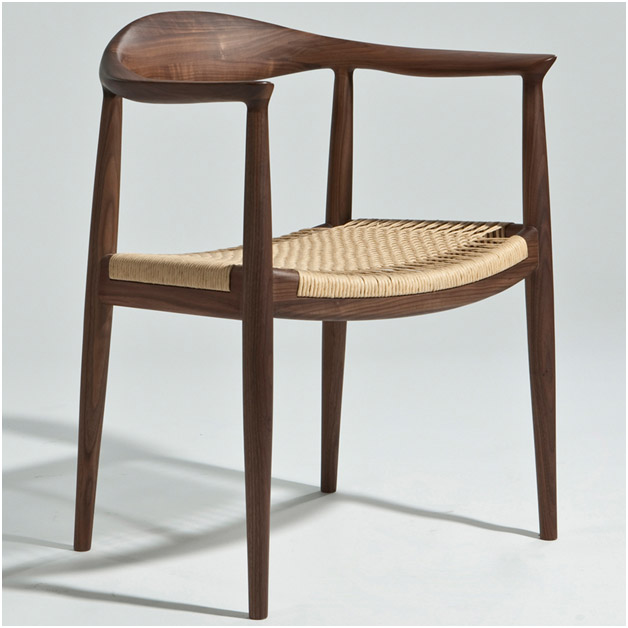 Shown above: Hans Wegner 501 Round Chair
Shown above: Hans Wegner 501 Round Chair
Poul Kjaerholm, sometimes compared to Wegner, was a Danish designer who emphasized the allure of steel in his designs. He pioneered the experimentation of steel in furnishings. His aim was to create elegant steel framed furniture that was lightweight yet extremely sturdy and showcased the artistry of steel. The PK22 chair, considered to be Kjaerholms most famous design, featured an ultra slim leather or woven cane seat and back with a steel frame which peeked out from the bottom of the seat and steel legs that charmingly flowed outwards. Another Kjaerholm design called the PK9 chair featured a leather seat and back with a plated steel 3 legged base that elegantly curved outwards. His designs changed the view on steel in mid-century modern furniture design, making it a highlighted aspect of the design.
 Shown above: Poul Kjaerholm PK22 Chair
Architect and danish designer, Arne Jacobsen, had a keen eye for detail and left no stone unturned when involving himself in his architectural projects which encompassed all interior design aspects like furnishings and decor. In fact, most of Jacobsens most popular designs were originally architectural commissions, designed for large companies, famous hotels and universities. For example, his iconic Swan Chair, Ant Chair and Egg Chair evolved from these architectural projects. These chairs were very fluid in form and highly sculptural.
Shown above: Poul Kjaerholm PK22 Chair
Architect and danish designer, Arne Jacobsen, had a keen eye for detail and left no stone unturned when involving himself in his architectural projects which encompassed all interior design aspects like furnishings and decor. In fact, most of Jacobsens most popular designs were originally architectural commissions, designed for large companies, famous hotels and universities. For example, his iconic Swan Chair, Ant Chair and Egg Chair evolved from these architectural projects. These chairs were very fluid in form and highly sculptural.
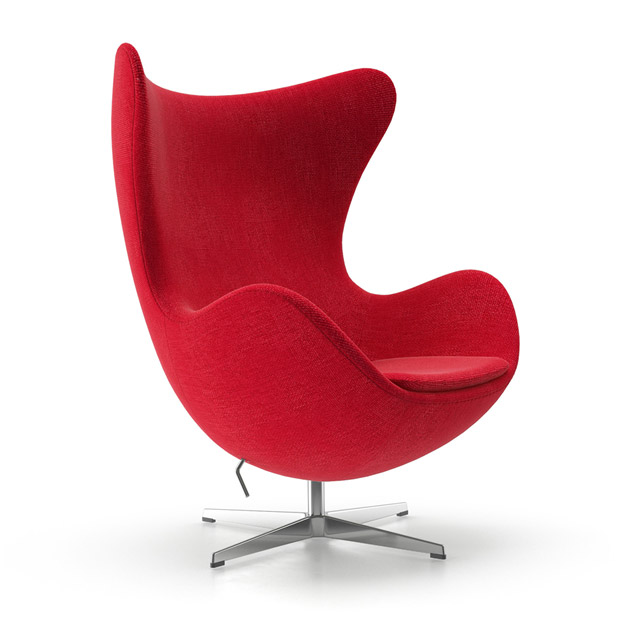 Shown above: Arne Jacobsen Egg Chair
Shown above: Arne Jacobsen Egg Chair
With the mind of an engineer and the eye of an artist, Jacobsen chose to design based on need, convenience and affordability for the buyer without compromising on style. His approach to design largely took into account the need of the personal consumer as well as the bigger picture in new developments in architecture, where during that time buildings were being made with smaller kitchens increasing the demand for a type of chair that could easily be stacked. This was how the well-known Series 7 Plywood Chair was born. It was a simple design made of plywood and a steel base, however, this stacking chair had style with a unique form and, a v-shaped back.
French innovator and engineer, Jean Prouve, focused his attention on turning his ideas into solutions and then creating them into good designs. His designs were of a semi-industrial look to them due to his use of raw materials in rugged plywood, tubular steel and nickel-plated metalwork. He experimented with flattening, extra-strong sections of tubular steel in his designs, a technique called ‘tube aplati.’ Prouve wanted his furniture to be progressive and affordable with a raw, utilitarian aesthetic to it. Prouve was the son of famous artist and painter Victor Prouve, a leading figure in the development of the French Art Nouveau in Nancy. Additionally, he was a part of the french resistance and after liberation was elected mayor of Nancy. His personal history of a man of many hats can be seen in his designs versatility and uniqueness.
Shown above: Jean Prouve Standard Chair Charles and Ray Eames were American design partners whom were one of the first to pioneer new materials in their designs and modeled their work in such as a way so as to provide furnishings for as many different types of peoples tastes and businesses of the time as possible. Eames introduced a series of chairs beginning with the Lounge Chair Wood in 1945. The classic chairs were made of plywood and were molded in such a way to fit the curves of the body. Following their plywood designs, they began to introduce a new material into the mix developed by the US military, the material was fiberglass which we see in many contemporary designs today.
Some of the most popular molded fiberglass chairs created by Eames were the La Chaise, the Rocking Arm Chair Rod, the Dining Armchair Rod and the Dining Side Rod. The chairs were either made of a wood and steel combination base or simply steel with a molded fiberglass seat - occasionally upholstered. The curves and contours of the molded fiberglass seating which came in a variety of solid yet eye-catching colors had a playful yet still professional appeal about them.
George Nelson, another American designer, was a key player in the mid-century modern design movement. He was an architect, artist, writer and journalist with an imaginative mind. He enjoyed turning home decor into a world of color and playfulness. Some of his best known and exciting design are the Coconut Chair and the Marshmallow Sofa. The Coconut chair was in the triangular shape of a slice of coconut and upholstered in a steel shell. The Marshmallow Sofa was a series of round individual cushions, evenly separated but all placed on one frame. The Marshmallow Sofa seat reflected the backrest giving it an eccentric yet symmetrical and structured look. These designs particular look as though they were taken straight from the pages of a comic book with their bizarre shapes and brilliant colors.
Nelson’s interest in architecture and design spanned farther than just creating the actual designs. He took it a step further by interviewing many of the pioneering designers and architects of the time and had his written works published in magazines that helped promote the interviewees and their designs as well as establish his personal connections within the design and art community.
While primarily examining seating design of this era, there were also numerous innovations in mid-century design decor and alternate furnishings. Lamps, clocks, mirrors, tables, dressers, chests, were booming with similar functional meets contemporary style of that era. The standards for interior design in the average home were changing and considering that more families were spending time at home, this was the perfect opportunity for beautiful and affordable home furnishings to re-enter the arena of consumers’ minds.
All of the mid-century modern designers mentioned used materials in their designs that did not compromise quality, aesthetic or comfort. Instead, they chose to actually experiment for themselves with uncommon materials in interesting ways that would be more cost efficient, faster to produce and express their personal style and originality. While each designer had their own uniquely different place in mid-century modern aesthetic, they share one distinct commonality. They focused on providing the audience of that time period with decor and furnishings that pin-point one aspect of the current cultural landscape, magnify it and reflect it back to them. Additionally, it is important to note that all of these designers worked closely with manufacturers who mass produced their creations and sometimes even helped fund the designers other artistic endeavors. This helps explain why the “birth time” of mid century modern aesthetic is a key component to its synergic formation.
After World War II, America as a whole was reestablishing its identity. It was time for a total cultural makeover. The desire for corporations to establish their image and for everyday people to stand out from the crowd, allowing their individuality to be known blossomed into the forefront of American culture. Additionally, life was moving at much faster rate following the war. The development of new technologies, products, mobility, manufacturing and production was at an all time high.
With a booming economy and a fresh perspective, this set the stage for mid-century modern designers to create innovative furnishings and unique decor fitting Americans free flowing attitude and brand new way of life.
Mid century modern designers were working with the times and in doing so, they established a genre of style that incorporated more efficient materials and focused on fluidity, vibrancy and symbolism with eyes pointing towards the future.
The emergence of design ideas from overseas, particularly European countries mixed with America’s new view was in large part due to the “global village” mentality as author, Marshall McLuhan eloquently put it. This was, of course, a result of the explosive burst in information technology, film, television and music.
What we have during this period is a total implosion of evocative innovations, fresh ideas, liberated minds and a boat load of outlets to choose from. Wherever there is a whirlwind of creative energy, expect a band of artists to be leading the way with a team of engineers close behind. This is why so many mid-century modern furnishings appear like beautiful sculptures and visionary works of art whilst serving an everyday, functional purpose.
The 1950’s and 60s’ were an exciting time in our history, an age that some may say never truly left us but simply took a short hiatus. In 2017, we see a revival of this modernist era, no doubt due to the World Wide Web, mobiles devices and of course, our insatiable hunger for new flavors of nostalgia. The question poses as to whether or not the innovations made whether it be in the realm of home furnishings or technological devices creates the cultural change or if these adaptations to the existing models and new inventions made are the cause of the cultural change in a particular society. It seems that they work in the way our universe functions, simultaneously together and having a symbiotic relationship where both sides influence and inspire one another. The balance between the two is a crucial component in sustaining a culture that is thriving in all arenas, from big business to small business to the single party and to the family unit. Examining one aspect of culture, like mid-century modern design, post World War II, serves as a microcosm to the bigger picture of the functionality of the system we collectively built.
The most refreshing and invigorating component of mid-century modern design is in the quest and knowledge of its origins. It seems that mid-century modern design is a term that continues to evolve with time, culture, technologies and our own personal lifestyles. The term is a mish mosh of ideas that encompass a moment where art transformed into more than something to be displayed or gazed at, it became a functional and affordable product for the average consumer. There was a massive shift in the relationship between art, design and production. The starving artist didn’t necessarily have to starve anymore, there was potential to make a solid living from your art by making it functional. This change in the cultural landscape for designers and artists breathed new life and possibility into the ways of making a living and even for the average buyer to have beautiful, quality furnishings in their homes.
Being surrounded by art and using that art for a purpose changes the mindset of those who may not be so inclined to make art, appreciate art or know if they can. As opposed to the observer simply observing the art in front of them, people have direct contact with the artwork and actually participate with it when it is a furnishing. This seemingly simple concept can influence individuals, businesses and culture just as powerfully as businesses and culture can influence individuals.
Every new piece of artwork uncovered or old design concepts that are rediscovered in which betters the lives of individuals, expands their view of themselves and their relationship with the world around them and enhances their perspective in a positively, transformative way is a revolutionary tool. Art can change the world. Art does change the world. Art did change the world (even if only parts of it!) during the mid-century period.
Mid-century modern furniture and decor is still widely collected by those with a thirst for history and a taste for functional artwork. Fortunately for us, there are places still keeping mid century modern furniture, decor and design alive and affordable with highly accurate reproductions of classic pieces invented in this starry-eyed era of design and in the true spirit of modernism, showcasing never before seen, original pieces in their stores.
You can explore and purchase a large selection of mid century modern furnishings and mid century modern decor described in this article as well as other contemporary furnishings at Inmod.com.

